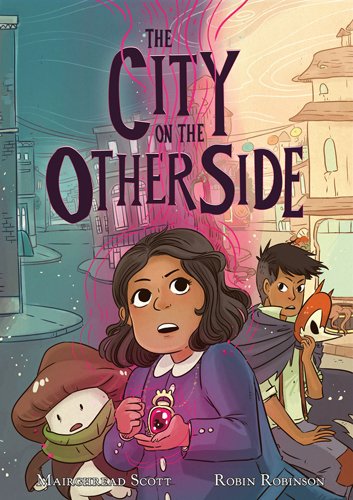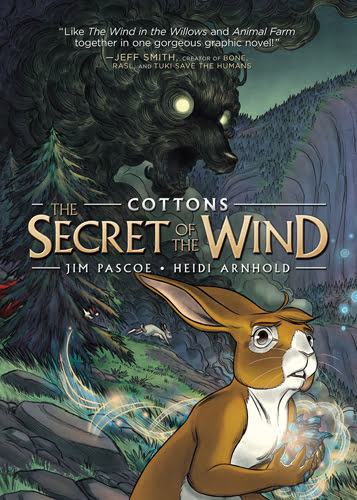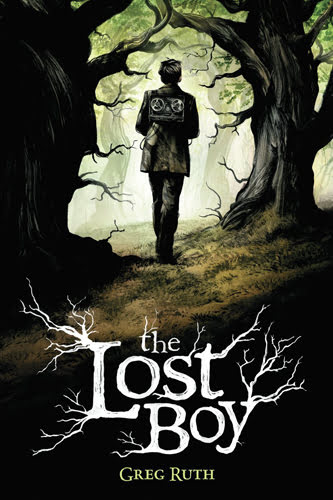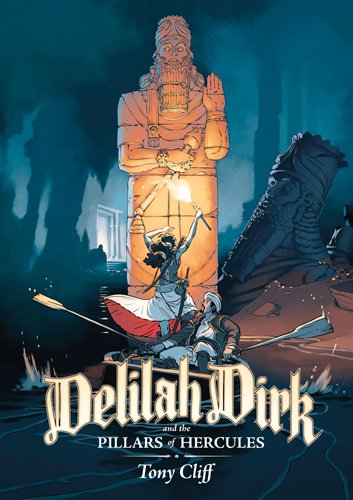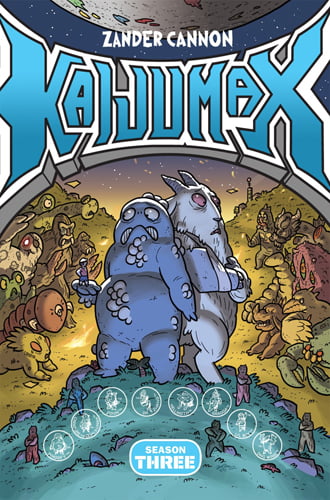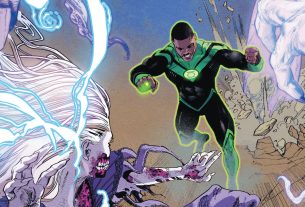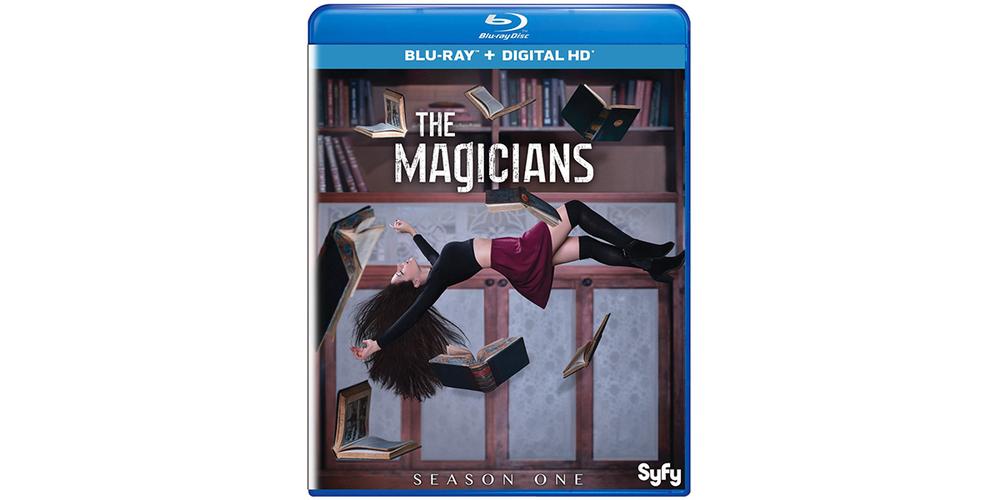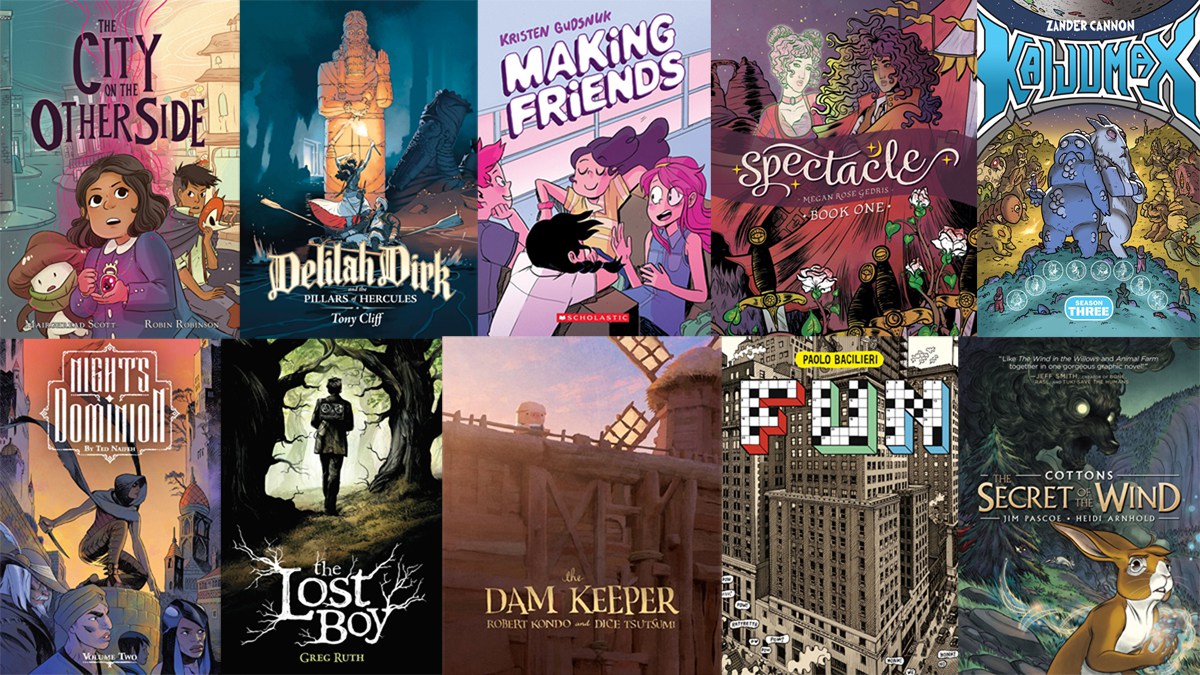 A couple weeks ago I had a comics grab bag post, and I ran out of time to write up all of the titles I’d been reading. So today’s column picks up where that one left off. Several of today’s titles deal with the spooky or otherworldly—something wicked (or at least creepy) this way comes—but there are a few titles in here that don’t include anything supernatural, too.
A couple weeks ago I had a comics grab bag post, and I ran out of time to write up all of the titles I’d been reading. So today’s column picks up where that one left off. Several of today’s titles deal with the spooky or otherworldly—something wicked (or at least creepy) this way comes—but there are a few titles in here that don’t include anything supernatural, too.
I’ll start with some titles for kids, and move up to teens and adults.
Making Friends by Kristen Gudsnuk
Dany isn’t having a great time in middle school so far. Her elementary school friends are in different classes, so she feels alone and a bit lost, while her friends seem to be thriving and making new friends. All that changes when she inherits an old sketchbook from her great-aunt, and discovers that the things she draws in there come to life! So she draws herself a new best friend: Madison, newly arrived from New York, who is fashionable and popular and shares all of Dany’s interests and, of course, is totally loyal to Dany. The trick, though, is that she doesn’t know she’s Dany’s creation, and eventually starts to ask questions.
The book has a lot of fun tackling the angst of middle school through this lens of magic: the first thing Dany brings to life is Prince Neptune, the evil—er, misunderstood—prince from her favorite cartoon series. Well, not all of Prince Neptune—just his head, because that’s all she sketched. Throughout the book, Prince Neptune is a great contrast to Madison: he also professes his love for Dany and offers his advice on becoming popular, though his suggestions tend to be a bit more controlling and, uh, evil. Hijinks ensue, and of course Dany learns some valuable life lessons, but not before putting her magical sketchbook to a lot of good use.
The City on the Other Side by Mairghread Scott, illustrated by Robin Robinson
San Francisco has not entirely recovered yet from the Great Quake of 1906, though Isabel has mostly been kept isolated from the affected portions of the city. She’s expected to be a proper little girl who keeps her dresses clean and shows up to meals on time. When she goes to visit her artist father, she stumbles into the world of faeries, and finds herself in the middle of a war between the Seelie and Unseelie.
Isabel is entrusted with a magical necklace that helps her reshape the city around her, which is a strange reflection of the San Francisco on the human side of the barrier. She’s accompanied by Button, a fearless mushroom man, and Benjie, a human boy who has the ability to jump between the human and faerie worlds. It’s up to them to stop the war, which is tearing apart both worlds. I really enjoyed this one, which had a diverse cast of faeries, a bit of a mystery to solve, and some great twists and turns.
The Dam Keeper and The Dam Keeper: World Without Darkness by Robert Kondo and Dice Tsutsumi
This series of graphic novels is based on the 2015 Oscar-nominated short of the same title (directed by Kondo and Tsutsumi), and the illustrations have a similar look to them: painted, with lots of texture and rough edges, but also with a sculptural quality that makes the figures look solid and real. The characters look cute, like something out of a kids’ show, but there’s a darkness to the story, too.
Pig is the Dam Keeper: his home is built into the dam, which protects the city from the mysterious fog on the other side. It’s his duty to crank the wheel at regular intervals, starting up the fan that keeps the darkness at bay, ever since his father walked into the fog and vanished. His friends—and the rest of the city’s population—don’t really understand the burden of this responsibility; safe inside the city, they don’t even really think about the fog anymore. Lately, though, the fog has been acting strangely, pulling back and returning in ever larger waves, and Pig worries that the dam won’t survive the next crash.
Pig, his friend Fox, and his not-really-a-friend Hippo wind up far from home on the other side of the dam, expecting instant death. What they encounter instead are other cities with their own dams, filled with other citizens, and more mysteries about the fate of Pig’s father. Meanwhile, Pig needs to find a way back home before the next wave of darkness will return to Sunrise Valley.
These two books are gorgeous hardcovers, and nearly every panel is worth framing and hanging on the wall. Kondo and Tsutsumi have both worked in animation (aside from the Dam Keeper short), and it shows: the book is very cinematic. The first two books are available now, with one more planned to wrap up the story. I’m eager to find out how it ends.
Cottons: The Secret of the Wind by Jim Pascoe, illustrated by Heidi Arnhold
Part Watership Down, part Wind in the Willows, with a good dose of magic: this book kicks off a trilogy about rabbits and foxes in the Vale of Industry, where carrots are processed into cha, a mysterious substance that gives the rabbits light and power. Bridgebelle works in the cha factory, but she longs to be an artist, using the cha to make thokchas, baubles that explode into beautiful patterns. At the same time, there are some foxes trying to gain control of the factory so they can use the power of thokchas as a weapon.
The animals in Cottons can speak and use machines, but they still look mostly like actual rabbits: they run on four legs and don’t wear clothing. Despite their industry, the rabbits are currently in a new Dark Age, relying on old technology to rebuild their civilization. The book depicts some of their rituals and spiritualism, along with various legends about rabbit culture that have been passed down.
The artwork is lovely, a good blend between cartoony and realistic that helps immerse you in this world. I was fascinated by the story and can’t wait to see where it goes next. There’s a lot going on here, with lots of things hinted at that aren’t fully explained by the end of the first volume.
The Lost Boy by Greg Ruth
This book is actually several years old, but I had just never gotten around to reading it. I guess you might say it was a bit of a lost book. Nate moves into a new house and finds an old reel-to-reel tape recorder under the floorboards of his room. When he starts listening to the tapes, he hears the voice of Walter Pidgin, a boy who lived in the house many years ago and eventually went missing. Then Nate starts to experience many of the same strange things that Walter describes in his tapes: a well-dressed giant insect riding a dog, a talking squirrel, a living doll boy.
Nate teams up with Tabitha, his neighbor, to investigate, and they get drawn into a world they never imagined existed. There’s a powerful enemy gathering up strength in the woods, and the two of them must confront it.
The story is illustrated in black and white, and jumps between the present day and the past, when Walter was making his recordings. I do see some parallels between this and The City on the Other Side, since both deal with the world of the unseen and the transitions between the two, but The Lost Boy is a bit less cartoony and a bit more eerie.
Delilah Dirk and the Pillars of Hercules by Tony Cliff
Coming in August, the third volume in the Delilah Dirk series is another exciting adventure. Delilah is a bit like Lara Croft, a bit like Indiana Jones, and then a bit like nobody else. She’s an expert swordfighter who travels the world in a flying boat, and isn’t afraid to break a few rules, particularly if there’s treasure involved. I mentioned the first two books in a previous Stack Overflow, and Jamie Greene interviewed Tony Cliff a couple years ago as well.
In this book, Delilah and her companion Selim meet Laurens Van Hassel, a Dutchman who writes for the Weekly Observer and is always looking for a good story. He shares a tip with Delilah about The Third Pillar of Hercules, a mysterious sunken city that controlled the Straits of Gibraltar, but had never been discovered. The three of them set out to find the lost city, but it’s not clear what Van Hassel’s real agenda is…
I really love this series: Delilah is such a great, over-the-top character. I love how enthusiastic and impulsive she is, which often gets her into trouble, but she’s also skilled and smart enough to get back out. Selim, on the other hand, is a little more level-headed, but has to work hard to keep up with Delilah. The illustrations are fantastic, great at capturing both the dynamic action sequences and the grandiosity of the archeological sites.
Night’s Dominion Volume 2 by Ted Naifeh
Emerane—also known as The Night—and her companions managed to defeat the undead army (see my take on volume 1 here) but the city is still in danger. This time, a new “peacekeeping” army has come to power, thanks to a combination of political manipulation and the Asps’ maneuvering. It’s time to get the band back together.
This volume doesn’t have as much of the supernatural—it’s mostly human machinations at work—but there’s still plenty of adventure and intrigue. And there’s not as much of the whole team working together—they’ve been separated for various reasons so you get some pairings and solo outings—but eventually they find each other, probably in preparation for the next chapter. This series is for teens and up, with some violence and sexuality.
Spectacle by Megan Rose Gedris
Twin sisters Kat and Anna are both performers in the Samson Brothers Circus: Kat is a knife-thrower and Anna is a psychic, though she doesn’t actually believe in the supernatural. She’s an engineer, working on her conjecture machine, able to predict future events with 78% accuracy, though she doesn’t use that for her performances—for those, she just reads people and tells them what they want to hear. All of that changes when Kat is murdered … and then her ghost takes up residence in Anna.
Jebediah Tetanus, the circus ringleader, doesn’t want word to get out about the murder to prevent panic, so it’s up to Anna (and Kat) to investigate the various members of the troupe. But the murder isn’t the only problem they have to deal with: the train is broken so the circus is stuck in town, Jebediah gets arrested by a corrupt sheriff, and some very strange things start happening at the circus. And it ends with a kicker of a cliffhanger.
I like the mystery and the ghost humor. The circus is populated with a whole host of odd characters, and I’m still in the dark about who did it, but I liked the various side plots and flashbacks in the first volume. Despite the cartoony style, there are a few graphic scenes, so this one’s for teens and up, not for younger readers.
Kaijumax Season 3: King of the Monstas by Zander Cannon
Things really heat up in the third volume of Kaijumax, a series about a maximum-security prison for giant monsters. The series mashes up familiar monster movie tropes with topics like police brutality, life in prison, racism, and gangs, in a way that is both entertaining and thought-provoking. There are good cops and bad cops, who can transform into monster-sized avatars (something about cosmic bonding and a giant alien race…): one has a secret affair with a prisoner, smuggling drugs in for the prison economy. Tensions are rising in Kaijumax as the various factions of monsters plot against each other, each angling for dominance.
The Creature from Devil Creek—or Daniel, as his mother calls him—features a little more heavily in this volume. He’s one of the smaller guys, a goat-like creature who doesn’t have a whole lot going for him. But it turns out he knows a pretty big secret about an unsolved murder. Will it be enough to protect him from the other prisoners, though? And what is it like when a monster prison experiences an all-out riot?
Fun by Paolo Bacilieri
This graphic novel is a mashup of fiction and non-fiction; it weaves the history of the crossword puzzle with the fictional story of Pippo Quester, a novelist who is writing a book about crossword puzzles, and Zeno Porno, a fan of Pippo’s who is helping him do research. And then there’s an attempted murder, which adds some more for Pippo and Zeno to puzzle over.
The book is told in a series of vignettes—sometimes it’s presented as the text that Pippo is typing into his manuscript. Sometimes it’s just Zeno out with his friends, or his kid. Sometimes there are other characters who may or may not tie into the ongoing story. It’s a bizarre sort of book, but the parts about crossword puzzles are indeed fun, and will be of interest to fans.
The illustrations are a curious mix: some characters are very cartoony or caricatured, but other details are quite realistic. Bacilieri also borrows a lot from movies, pointing out characters or items that were inspired by (or directly taken from) movies. The one thing I thought was really odd, though, was a section of dialogue that is taken from Chinatown and presented as a passage from one of Pippo’s novels. Although Chinatown is listed in the bibliography at the end, there’s no indication during the story that that portion wasn’t original.
For the most part, though, I found the book really fascinating, if a bit hard to follow in places.
Best of Enemies: A History of US and Middle East Relations by Jean-Pierre Filiu and David B.
We’ll end with this non-fiction series, a trio of books about the US and the Middle East, from 1783 to 2013. It traces the long history of the complex relationships between the US and the Middle East, as well as some other international relations, from piracy to oil, from diplomacy to war. Social studies had never been my strong suit in school, and I admit that I had only a vague notion of what was happening in the rest of the world when I was a kid; reading these books brought back a lot of names and places that I remember hearing on the news, and provided a better context for me. It also sheds light on how American policies have sometimes backfired, and none of the U.S. Presidents really come out looking great.
The book does jump around in history sometimes, because there are so many things going on at once, so it can get confusing when it jumps back to an earlier time or skips over years. For instance, right after a panel about George W. Bush winning a second term, the next page is about Barack Obama.
The illustrations, by David B., are often symbolic instead of realistic. If you’ve seen his work before, you’ll be familiar with his style, which is bold and full of exaggerated features. Faces become tanks, with guns for eyes. People are depicted at different scales, with those in control towering over their subordinates. The drawings evoke a more visceral reaction than the text alone or a straight depiction of the events probably would.
It’s a lot to digest all at once, and I feel like I need to go back and read it again because I haven’t retained it all. Certainly it’s not an in-depth analysis of the topic, but these three books provide an overview of a broad swath of conflict-ridden history, and I recommend it.
My Current Stack
I finished reading Hidden Things by Doyce Testerman. It’s a novel, not a comic book, but it may still fit in with the supernatural theme that many of today’s books share. Calliope Jenkins is a private detective; her best friend (and business partner and former lover) calls her in the middle of the night from an investigation, and turns up dead shortly thereafter. But something’s not right, and I’m not just talking about foul play. Calliope is soon ushered into a world of hidden things—the not-people who hide in plain sight, and the others who have secreted themselves away to another place entirely. Her guide is Vikous, who looks a bit like a homeless man in clown makeup and has very unusual abilities. I really liked the way that this other world was portrayed, and its explanations for various things like geography and unusual people. It reminded me in some ways of American Gods, mostly because it brings together a bit of the old world and the modern world.
Speaking of American Gods, I picked up Shadows, the first hardcover collection of the graphic novel, at the bookstore recently and enjoyed it. I know it’s well into the second portion of the story now, but I like reading them in collections, so I’ll be waiting for the My Ainsel storyline to be collected to continue the story. It’s a good adaptation of Gaiman’s novel, and reminds me again what I enjoyed so much about reading the novel.
I’m currently reading The Con Artist by Fred Van Lente, picked because this coming week is San Diego Comic-Con. It’s a murder mystery set at Comic-Con, with a has-been comic book artist as the main character and narrator. I think Jim Kelly will be working on a full review of it soon, but so far I’m enjoying the descriptions of the convention (which I haven’t been to since 2010).
Disclosure: I received review copies of the titles in this column.

